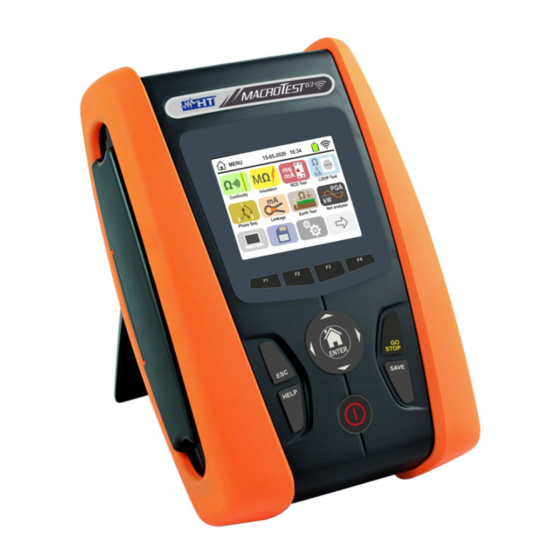
Table of Contents
Advertisement
Advertisement
Table of Contents

Summarization of Contents
Precautions and Safety Measures
Preliminary Instructions
Essential guidelines for instrument setup and initial use.
During Use
Critical recommendations for safe and accurate operation during measurements.
After Use
Procedures for powering down and storing the instrument.
Definition of Measurement Category
Explanation of measurement categories (CAT IV, III, II, I) for installation safety.
General Description
Foreword
Introduction to the manual and instrument models covered.
Instrument Functions
Overview of the instrument's capabilities and measurement types.
Preparation for Use
Initial Checks
Steps for verifying the instrument's condition and package contents.
Instrument Power Supply
Information on powering the instrument using batteries or charger.
Storage
Recommendations for storing the instrument under specific environmental conditions.
Nomenclature
Instrument Description
Identification of front and upper part components and their labels.
Measuring Leads Description
Details on the design and safety features of measuring leads.
Keyboard Description
Explanation of the function of each key on the instrument.
Display Description
Overview of the instrument's LCD display features and information shown.
Initial Screen
Information presented on the screen when the instrument is switched on.
General Menu
Instrument Settings
Accessing and configuring various instrument parameters.
System Language Setting
Procedure for selecting the display language of the instrument.
Reference Country Setting
Setting the country, affecting measurement results and interface.
Automatic Power OFF
Configuration of auto-off timer for display and key sound.
System Settings
Setting electrical system type, frequency, and voltage limits.
Operator Name Entry
Entering an operator's name for measurement records.
System Date/Time Setting
Adjusting the instrument's internal date and time.
Information
Accessing instrument model, firmware, serial number, and calibration date.
Operating Instructions
RPE: Continuity Test
Performing continuity tests on protective conductors according to standards.
M: Insulation Resistance Measurement
Measuring insulation resistance between conductors and earth.
RCD: Test on Differential Switches
Testing tripping time and current of differential switches (RCDs).
LOOP: Line Impedance Measurement
Measuring line and fault loop impedance and short-circuit current.
SEQ: Phase Sequence Test
Testing phase sequence and concordance in three-phase systems.
LEAKAGE: Leakage Current Measurement
Measuring leakage current using an external clamp accessory.
EARTH: Earth Resistance Measurement
Measuring earth resistance using 3-wire, 2-wire, or clamp methods.
AUX: Ambient Parameters Measurement
Measuring environmental parameters like temperature and humidity.
ΔV%: Voltage Drop Measurement
Evaluating voltage drop percentage on main power lines.
AUTO TEST: Automatic Sequence
Performing an automatic sequence of NoTrip, RCD, and Insulation tests.
EVSE: Safety Test for Electric Cars
Performing safety tests on electric car charging stations with an adapter.
Operations with the Memory
Saving Measurements
Procedures for saving measurement results with markers and comments.
Recalling and Deleting Memory
Accessing saved measurements and managing instrument memory.
Connecting to PC or Mobile Devices
Connection to PC (Optical/USB Cable)
Connecting the instrument to a PC using a USB cable for data transfer.
Connection to PC via WiFi
Establishing a WiFi connection between the instrument and a PC.
Connection to iOS/Android via WiFi
Connecting to smartphones/tablets via WiFi using the HTAnalysis app.
Maintenance
General Information
General recommendations for instrument care and usage.
Battery Replacement
Step-by-step guide for replacing or recharging instrument batteries.
Cleaning the Instrument
Instructions for cleaning the instrument's exterior.
End of Life
Information regarding proper disposal of the instrument at its end of life.
Technical Specifications
Technical Characteristics
Detailed specifications, ranges, resolutions, and accuracies for measurements.
Reference Guidelines
List of relevant safety and EMC standards the instrument complies with.
General Characteristics
Physical, power, and interface specifications of the instrument.
Environment
Operating and storage conditions for the instrument.
Accessories
Reference to the packing list for included accessories.
Service
Warranty Conditions
Terms and conditions of the instrument's warranty coverage.
Service
Procedures for instrument troubleshooting and returning for service.
Theoretical Appendixes
Continuity of Protective Conductors
Theoretical background and allowable values for continuity testing.
Insulation Resistance
Theoretical explanation and common test values for insulation resistance.
Checking Circuit Separation
Principles and purpose of testing circuit separation (SELV, PELV).
Test on Differential Switches (RCD)
Theoretical basis for RCD testing and allowable tripping times.
Verify Breaking Capacity of Protection Devices
Principles for checking the breaking capacity of protection devices.
Verify Protection Against Indirect Contacts in TN Systems
Ensuring protection against indirect contacts in TN systems.
No Trip Test in TN Systems
Performing the NoTrip test for indirect contact protection in TN systems.
Verify Protection Against Indirect Contacts in TT Systems
Ensuring protection against indirect contacts in TT systems.
Verify Protection Against Indirect Contacts in IT Systems
Ensuring protection against indirect contacts in IT systems.
Verify Protection Coordination L-L, L-N, L-PE
Testing coordination of protective devices based on short-circuit current.
Verify Protection Against Short Circuits – Test I²t
Evaluating protection against short circuits using the I²t parameter.
Verification of Voltage Drop on Main Lines
Calculating and verifying voltage drop on power lines.
Measurement of Earth Resistance in TN Systems
Calculating earth resistance based on allowable contact voltage.
Voltage and Current Harmonics
Understanding voltage and current harmonics in electrical systems.
Presence of Harmonics: Causes
Explaining the sources and causes of harmonic distortion.
Presence of Harmonics: Consequences
Discussing the effects and implications of harmonic presence.
Calculation of Powers and Power Factors
Formulas for calculating electrical powers and power factors.














Need help?
Do you have a question about the SUPERCOMBI and is the answer not in the manual?
Questions and answers